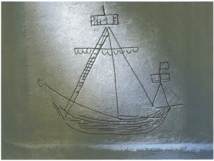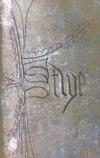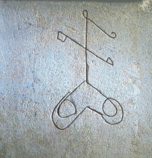Graffito (archaeology)
A graffito (plural "graffiti"), in an archaeological context, is a deliberate mark made by scratching or engraving on a large surface such as a wall. The marks may form an image or writing. The term is not usually used of the engraved decoration on small objects such as bones, which make up a large part of the Art of the Upper Paleolithic, but might be used of the engraved images, usually of animals, that are commonly found in caves, though much less well known than the cave paintings of the same period; often the two are found in the same caves. In archaeology, the term may or may not include the more common modern sense of an "unauthorised" addition to a building or monument. Sgraffito, a decorative technique of partially scratching off a top layer of plaster or some other material to reveal a differently coloured material beneath, is also sometimes known as "graffito".
Listings of graffito
Basic categories of graffiti in archaeology are:
- Written graffiti, or informal inscriptions.
- Images in graffiti.
- Complex, merged, or multiple category graffiti.
Ancient Egypt graffiti
Modern knowledge of the history of Ancient Egypt was originally derived from inscriptions, literature, (Books of the Dead), pharaonic historical records, and reliefs, from temple statements, from and numerous individual objects whether pharaonic or for the Egyptian citizenry. Twentieth century developments led to finding less common sources of information indicating the intricacies of the interrelationships of the pharaoh, his appointees, and the citizenry.
Three minor sources have helped link the major pieces of interrelationships in Ancient Egypt: ostraca, scarab artifacts, and numerous temple, quarry, etc. sources have helped fill in minor pieces of the complex dealings in Ancient Egypt. The reliefs, and writings with the reliefs, are often supplemented with a graffito, often in hieratic and discovered in locations not commonly seen, like a doorjamb, hallway, entranceway, or the side or reverse of an object.
Late (Roman) Demotic graffito

Very Late Egyptian Demotic was used only for ostraca, mummy labels, subscriptions to Greek texts, and graffiti. The last dated example of Egyptian Demotic is from the Temple of Isis at Philae, dated to 11 December 452 CE. See Demotic "Egyptian".
Sator square
The Sator square is a Latin graffito found at numerous sites throughout the Roman Empire (e.g. Pompeii, Dura-Europos) and elsewhere (United Kingdom).
Deir el-Bahri religious graffiti
Pilgrims to religious sites left numerous graffiti at the Egyptian site of Deir el-Bahri.[1]
-

Malta temple graffito: Mnajdra
Graffiti in ancient Athens
Large quantities of graffiti have been found in Athens during excavations by the American School of Classical Studies at Athens; nearly 850 were catalogued by Mabel Lang in 1976.[2] These include a variety of different types of graffiti, such as abecedaria, kalos inscriptions, insults, marks of ownership, commercial notations, dedications, Christian inscriptions, messages, lists and pictures. They date from the eighth century BC through to the late Roman period.
Medieval church graffiti
Graffiti dating from the fourteenth to seventeenth centuries have recently been studied in Norfolk, England. The examples below are from Saint Nicholas, the parish church of Blakeney.[3][4]
-

A ship graffito
-

Graffito with a decorated capital letter
-

A mason's mark
See also
- Ancient Maya graffiti
- Graffiti
- Ostracon
- Scarab artifact
References
- ↑ Parkinson, R. Cracking Codes, the Rosetta Stone, and Decipherment, Richard Parkinson, with W. Diffie, M. Fischer, and R.S. Simpson, (University of California Press), c. 1999. Section: page 92, "Graffiti" from a temple at Deir el-Bahri. British Museum pieces, EA 1419, 47962, 47963, 47971.
- ↑ M. Lang, 1976. The Athenian Agora Volume XXI: Graffiti and Dipinti. Princeton: The American School of Classical Studies at Athens.
- ↑ Champion, Matthew (2011). "Walls have ears, noses, ships". Cornerstone 32 (2): 28–32.
- ↑ Norfolk medieval graffiti survey
Further reading
- Ceram, C.W. The March of Archaeology, C.W. Ceram, translated from the German, Richard and Clara Winston, (Alfred A. Knopf, New York), c 1958.
External links
| Wikimedia Commons has media related to Ancient graffiti. |
- Sator Square, inscribed, Article; the article uses: "Rotas square"
.jpg)
